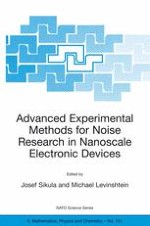2004 | OriginalPaper | Buchkapitel
Noise and Tunneling Through the 2.5 nm Gate Oxide in Soi MOSFETs
verfasst von : N. Lukyanchikova, E. Simoen, A. Mercha, C. Claeys
Erschienen in: Advanced Experimental Methods For Noise Research in Nanoscale Electronic Devices
Verlag: Springer Netherlands
Enthalten in: Professional Book Archive
Aktivieren Sie unsere intelligente Suche, um passende Fachinhalte oder Patente zu finden.
Wählen Sie Textabschnitte aus um mit Künstlicher Intelligenz passenden Patente zu finden. powered by
Markieren Sie Textabschnitte, um KI-gestützt weitere passende Inhalte zu finden. powered by
It is shown that some peculiar features are typical for the drain current noise spectra of SOI MOSFETs with 2.5 nm gate oxide. In the frequency range 0.7 Hz≤f≤50 Hz a drain current spectral density is observed which follows a 1/f1.7 law for a broad range of operation conditions. It is demonstrated that this noise is only found in the front-channel current and is observed both in SOI and bulk MOSFETs. The model proposed considers this noise as being generated by carriers tunneling between the front channel and traps associated with the polysilicon gate/oxide interface and situated sufficiently close to the channel in the case of an ultra-thin gate oxide. When the absolute value of the gate voltage is equal or higher than 1 V, a Lorentzian component appears in the noise spectra measured in the linear regime. It is shown that the Lorentzian amplitude SI(0) can be described by the formula SI(0)=Bτ(VDS)2/L3 where B is a coefficient, τ is the Lorentzian time constant that decreases exponentially with increasing gate voltage, VDS is the drain voltage and L is the channel length. The mechanism proposed for this noise is based on the idea that it originates from the filtered shot noise induced by majority carriers which are injected in the floating body of the transistor by electron valence-band tunneling across the ultra-thin gate oxide. Therefore, the appearance of both noise components can be regarded as thinoxide noise effects.
